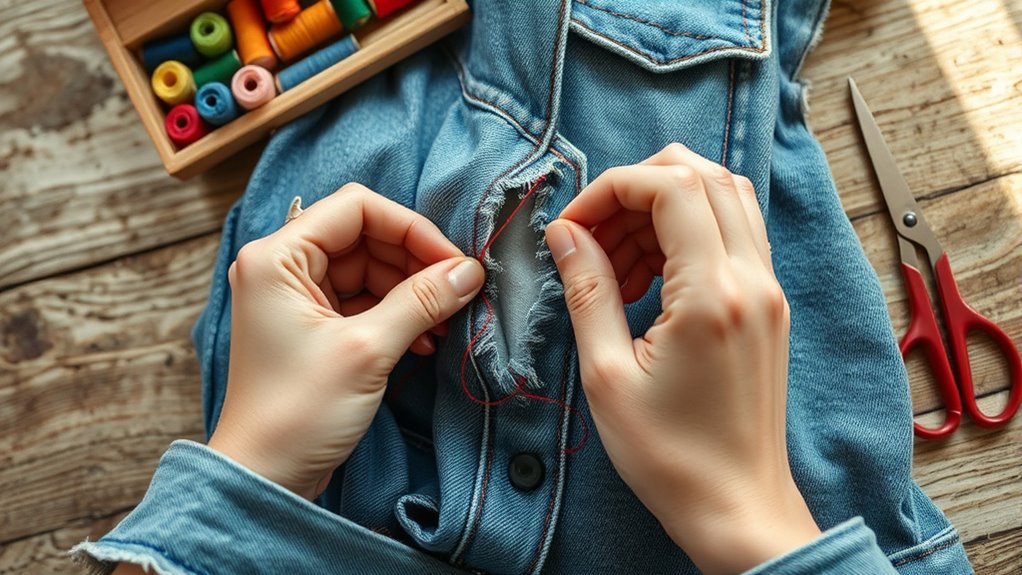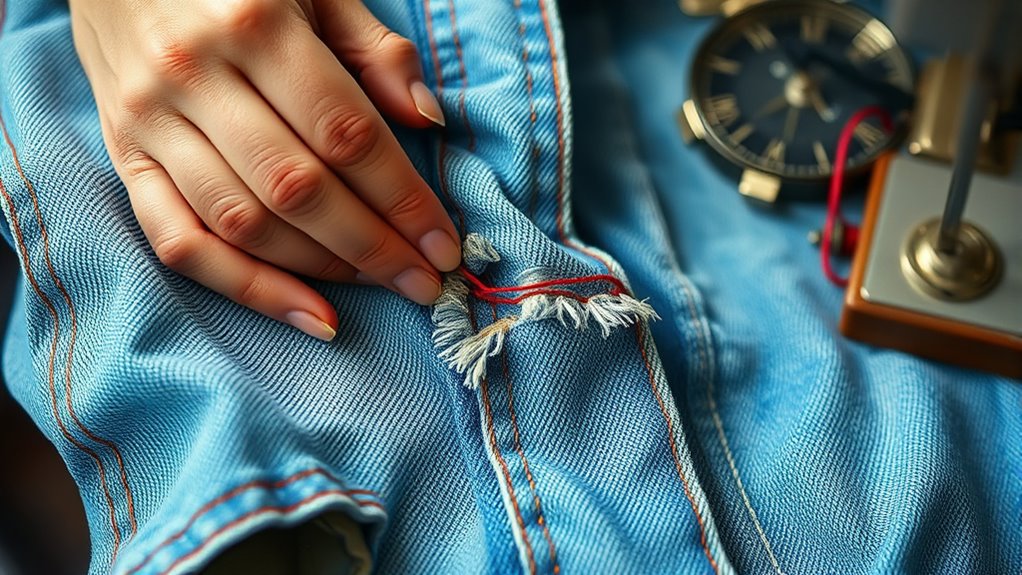By mastering simple repairs like sewing buttons, patching tears, and hemming clothes, you can extend the life of your garments and delay costly replacements. Assess damage carefully and use basic techniques to make secure, almost invisible fixes. Reinforcing worn areas with patches or neat stitches keeps clothes looking fresh and functional longer. Keep practicing these skills, and you’ll find ways to keep your wardrobe in great shape without spending more—discover more tips along the way.
Key Takeaways
- Repair tears and holes promptly with matching thread or patches to extend garment lifespan.
- Replace missing or loose buttons quickly to maintain functionality and appearance.
- Hem or shorten clothing using simple stitches to update fit and avoid replacement.
- Reinforce high-stress areas to prevent further damage and prolong wearability.
- Learn basic sewing techniques to perform quick, cost-effective repairs at home.

Clothing repairs can save you money and extend the life of your favorite pieces, especially when you know some simple DIY techniques. When a garment tears or shows signs of wear, replacing it might seem like the only option, but with a little effort, you can often fix it yourself. Fabric mending is a skill that allows you to restore clothing without the expense of buying new, and mastering basic sewing techniques makes all the difference. Whether it’s a small tear, a loose button, or a frayed hem, these repairs are straightforward once you understand the fundamentals.
Learn simple DIY clothing repairs to save money and extend your wardrobe’s life.
Start by evaluating the damage carefully. For small tears or holes, fabric mending with needle and thread can be surprisingly simple. Choose a matching thread color to make your repair less noticeable, and use a fine sewing technique like a whip stitch or backstitch to secure the fabric together. These stitches are strong yet discreet, ensuring the repair holds up through regular wear. If the tear is larger or in a high-stress area, reinforce it with a small patch of similar fabric, sewn neatly over the damaged section. This not only prolongs the garment’s life but also keeps it looking presentable. Additionally, understanding the role of contrast ratio in visual quality can help you assess the overall appearance and ensure your repair blends well with the original fabric.
Buttons often come loose or fall off, and replacing them is an easy fix with basic sewing techniques. Use a needle and thread to securely sew the button back on, making sure to go through the button’s holes multiple times for durability. For missing buttons, simply attach a new one by aligning it with the original placement, and sew it firmly into place. This simple repair can save you the cost of buying new shirts or pants, and it takes just a few minutes.
Hemming pants or skirts is another common repair that you can do yourself. If your clothing has become too long, a quick fold and sew with a needle and thread or a sewing machine can make a big difference. Use a straight stitch to secure the hem, making sure it’s even and neat. Shortening or adjusting the length of a garment not only saves money but also allows you to customize your wardrobe easily.
Incorporating these basic sewing techniques and fabric mending skills into your routine empowers you to fix minor clothing issues quickly and affordably. With a little patience and practice, you can delay replacement costs considerably and keep your wardrobe looking fresh. These DIY repairs are not only budget-friendly but also give you a sense of accomplishment and control over your clothing. Once you master these simple techniques, you’ll find it’s easier than you thought to extend the life of your garments and avoid unnecessary expenses.
Frequently Asked Questions
How Can I Identify Which Clothing Repairs Are Worth Doing Myself?
When deciding if a clothing repair is worth doing yourself, consider your mending techniques and fabric matching skills. If the tear or stain is minor and you’re confident in matching fabrics, it’s often worth repairing. Look at the garment’s value and how easy it is to match the fabric. If you’re skilled with mending techniques and can seamlessly blend the repair, you’ll save money and extend your clothes’ lifespan.
What Tools Are Essential for DIY Clothing Repairs?
To effectively handle DIY clothing repairs, you’ll need some essential tools. A good sewing kit with needles, thread, and scissors is fundamental. A sewing machine helps with more durable repairs and sewing machine maintenance keeps it running smoothly. Fabric patching techniques are crucial for fixing holes or tears, so keep fabric patches, pins, and a seam ripper handy. These tools make repairs easier, saving you money and prolonging your clothes’ lifespan.
How Long Do DIY Clothing Repairs Typically Last?
Imagine fixing a torn seam on your favorite jeans. The repair’s longevity depends on fabric durability and your skill. Typically, DIY clothing repairs last several months to a few years, often matching store-bought repairs if done well. Properly reinforced stitches and quality materials enhance repair longevity. With careful work, you can extend the life of your clothes, delaying replacement costs and making each repair a worthwhile investment.
Are There Any Safety Precautions for Sewing Repairs?
When sewing repairs, safety precautions are essential to avoid hazards. Always wear safety gear like thimbles, protective glasses, and gloves to prevent injuries from sewing needles or sharp tools. Keep your workspace organized, and be cautious with pins and scissors to avoid punctures or cuts. Stay attentive, and never rush, as sewing hazards can cause accidents. Using proper safety gear guarantees your repairs are safe and effective, reducing the risk of injury.
When Should I Seek Professional Help Instead of DIY Repairs?
When stitches start slipping or seams seem strained, it’s time to seek professional tailoring. If fabric replacement feels formidable or you notice persistent problems, don’t delay—reach out to experts. They’ll handle complex repairs carefully and correctly, preventing further damage. Trust professional help for precision and peace of mind, especially when DIY efforts fall flat or fabric frays beyond simple fixes. Prioritize safety and quality over quick fixes, ensuring your clothing stays fabulous and functional.
Conclusion
By learning simple DIY clothing repairs, you can extend your wardrobe’s life and save money. Did you know that the average American wardrobe is replaced every 3.5 years, costing over $1,700 annually? By repairing tears or replacing buttons yourself, you not only cut costs but also reduce waste. With just a few basic skills, you’ll be surprised how much longer your clothes last, making a smarter, more sustainable choice for your fashion habits.










